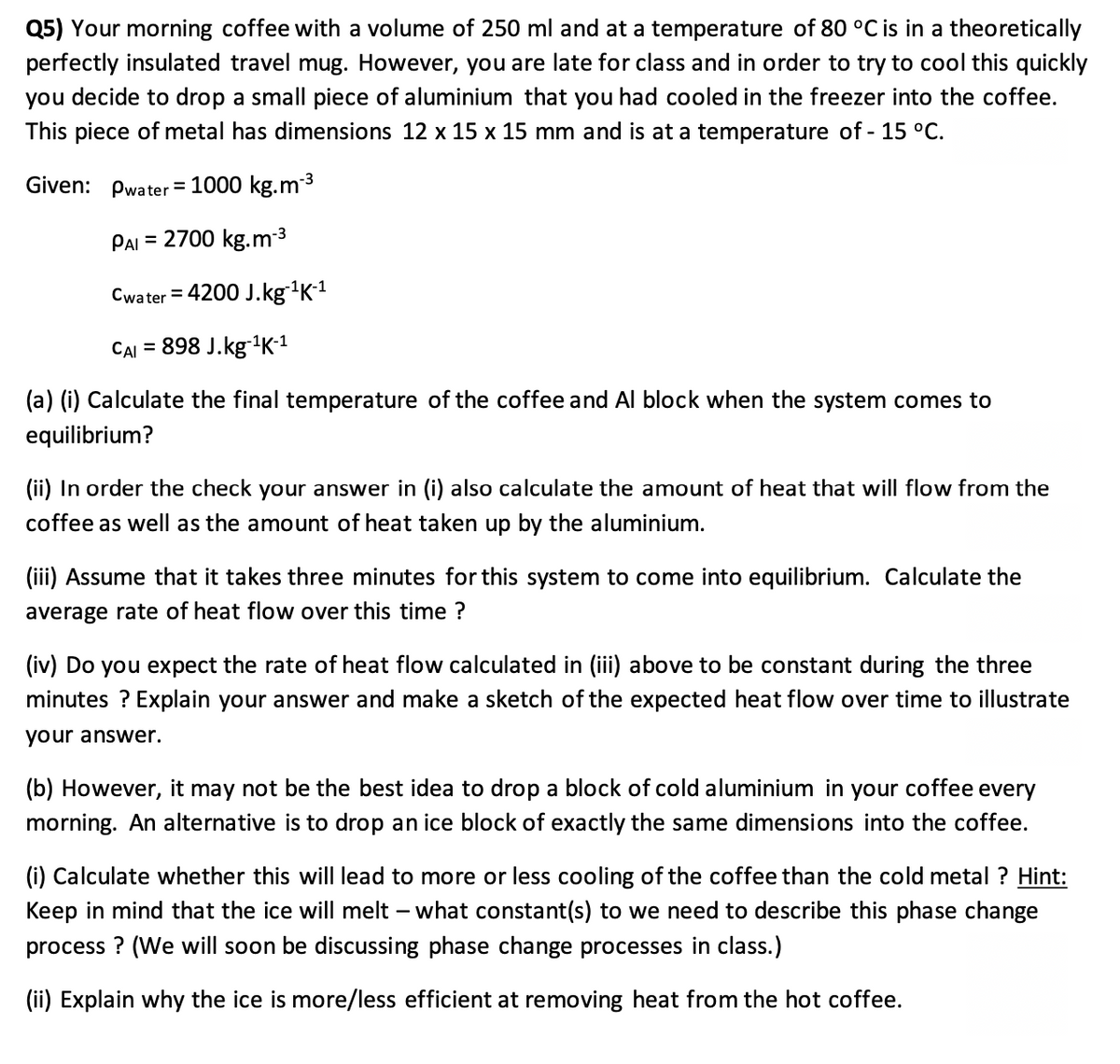(a) (i) Calculate the final temperature of the coffee and Al block when the system comes to equilibrium? (ii) In order the check your answer in (i) also calculate the amount of heat that will flow from the coffee as well as the amount of heat taken up by the aluminium. (iii) Assume that it takes three minutes for this system to come into equilibrium. Calculate the average rate of heat flow over this time ? (iv) Do you expect the rate of heat flow calculated in (ii) above to be constant during the three minutes ? Explain your answer and make a sketch of the expected heat flow over time to illustrate your answer. (b) However, it may not be the best idea to drop a block of cold aluminium in your coffee every morning. An alternative is to drop an ice block of exactly the same dimensions into the coffee.
(a) (i) Calculate the final temperature of the coffee and Al block when the system comes to equilibrium? (ii) In order the check your answer in (i) also calculate the amount of heat that will flow from the coffee as well as the amount of heat taken up by the aluminium. (iii) Assume that it takes three minutes for this system to come into equilibrium. Calculate the average rate of heat flow over this time ? (iv) Do you expect the rate of heat flow calculated in (ii) above to be constant during the three minutes ? Explain your answer and make a sketch of the expected heat flow over time to illustrate your answer. (b) However, it may not be the best idea to drop a block of cold aluminium in your coffee every morning. An alternative is to drop an ice block of exactly the same dimensions into the coffee.
College Physics
1st Edition
ISBN:9781938168000
Author:Paul Peter Urone, Roger Hinrichs
Publisher:Paul Peter Urone, Roger Hinrichs
Chapter14: Heat And Heat Transfer Methods
Section: Chapter Questions
Problem 42PE: (a) Calculate the rate of heat conduction through a double-paned window that has a 1.50m3 area and...
Related questions
Question
question in photo please

Transcribed Image Text:Q5) Your morning coffee with a volume of 250 ml and at a temperature of 80 °C is in a theoretically
perfectly insulated travel mug. However, you are late for class and in order to try to cool this quickly
you decide to drop a small piece of aluminium that you had cooled in the freezer into the coffee.
This piece of metal has dimensions 12 x 15 x 15 mm and is at a temperature of - 15 °C.
Given: Pwater = 1000 kg.m3
PAI = 2700 kg.m-3
Cwater = 4200 J.kg1K-1
CAI = 898 J.kg ²K-1
(a) (i) Calculate the final temperature of the coffee and Al block when the system comes to
equilibrium?
(ii) In order the check your answer in (i) also calculate the amount of heat that will flow from the
coffee as well as the amount of heat taken up by the aluminium.
(iii) Assume that it takes three minutes for this system to come into equilibrium. Calculate the
average rate of heat flow over this time ?
(iv) Do you expect the rate of heat flow calculated in (iii) above to be constant during the three
minutes ? Explain your answer and make a sketch of the expected heat flow over time to illustrate
your answer.
(b) However, it may not be the best idea to drop a block of cold aluminium in your coffee every
morning. An alternative is to drop an ice block of exactly the same dimensions into the coffee.
(i) Calculate whether this will lead to more or less cooling of the coffee than the cold metal ? Hint:
Keep in mind that the ice will melt – what constant(s) to we need to describe this phase change
process ? (We will soon be discussing phase change processes in class.)
(ii) Explain why the ice is more/less efficient at removing heat from the hot coffee.
Expert Solution
This question has been solved!
Explore an expertly crafted, step-by-step solution for a thorough understanding of key concepts.
Step by step
Solved in 4 steps with 1 images

Knowledge Booster
Learn more about
Need a deep-dive on the concept behind this application? Look no further. Learn more about this topic, physics and related others by exploring similar questions and additional content below.Recommended textbooks for you

College Physics
Physics
ISBN:
9781938168000
Author:
Paul Peter Urone, Roger Hinrichs
Publisher:
OpenStax College

College Physics
Physics
ISBN:
9781305952300
Author:
Raymond A. Serway, Chris Vuille
Publisher:
Cengage Learning

Physics for Scientists and Engineers, Technology …
Physics
ISBN:
9781305116399
Author:
Raymond A. Serway, John W. Jewett
Publisher:
Cengage Learning

College Physics
Physics
ISBN:
9781938168000
Author:
Paul Peter Urone, Roger Hinrichs
Publisher:
OpenStax College

College Physics
Physics
ISBN:
9781305952300
Author:
Raymond A. Serway, Chris Vuille
Publisher:
Cengage Learning

Physics for Scientists and Engineers, Technology …
Physics
ISBN:
9781305116399
Author:
Raymond A. Serway, John W. Jewett
Publisher:
Cengage Learning

College Physics
Physics
ISBN:
9781285737027
Author:
Raymond A. Serway, Chris Vuille
Publisher:
Cengage Learning

Physics for Scientists and Engineers
Physics
ISBN:
9781337553278
Author:
Raymond A. Serway, John W. Jewett
Publisher:
Cengage Learning

Physics for Scientists and Engineers with Modern …
Physics
ISBN:
9781337553292
Author:
Raymond A. Serway, John W. Jewett
Publisher:
Cengage Learning